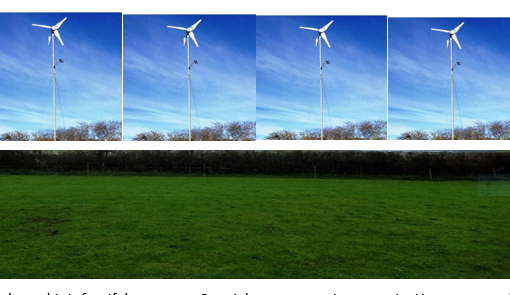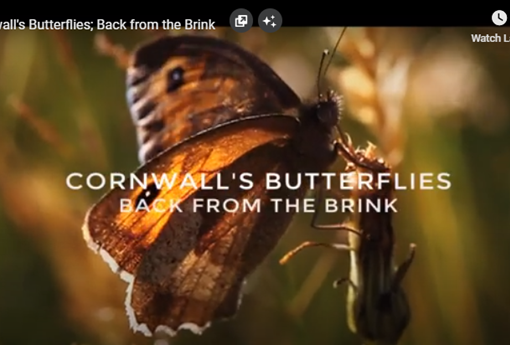29th September
A few short films – i) Secret threats to England’s justice system; ii) 2 contrasting stories from Shetland, iii) a little more about temperate rainforest and iv) an ending about chicken (!) and our upcoming Half Term events.
To my annoyance all plans for last Monday had to go out of the window, in favour of a trip to Truro. I don’t know what I would do without Giles at Computer Corner and mercifully he once again was able to sort out some chaos caused by Microsoft! But as I was about to leave, I ran into some folks I have not seen for well over 20 years … and was really surprised to find out they were in Truro to support a protest outside the Magistrates Court. What was this about?

The protesters were convened to raise awareness of a shockingly little-known proposal to remove jury decisions and replace with just one Judge ruling in many situations, frequently in order to ‘muzzle’ peaceful protesters. With this also comes a removal of the scope for moral arguments and extenuating circumstances to be taken into account, in a range of situations.
The following short report sums up the way these new, draconian laws were hustled through.
It gives me a big worry, as right now I know one of our blog readers has a grandson in the High Court for having participated in Extinction Rebellion protests. I don’t support outright law-breaking or major disruption of travel, but peaceful protests … yes! This video from Truro is ringing many alarm bells!
Shetland – Stop Rosebank
This week the government granted a licence for exploration of an extensive (up to 350m barrels) oil and gas field about 80 miles NW of Shetland. We have one reader, whose sister-in-law lives in Shetland, so I thought I really want to look into this further and ask him about local opinions.
https://www.scotsman.com/news/politics/controversial-rosebank-oil-field-is-granted-approval-4350048
As you might have expected, the heading says ‘Controversial’, which we will see is very much an understatement, but many objections fell on deaf ears. For instance, an excellent short film ‘Dear Norway’, which was a message sent in a bottle, literally, from Shetlanders to the Norwegians who will develop Rosebank, was totally ignored:-
https://www.independent.co.uk/news/uk/home-news/rosebank-oil-field-approved-b2419328.html
Also ignored were the concerns of Friends of the Earth, who had previously said ‘the project would involve Equinor installing a pipeline through a protected area off the Shetland coast – the Faroe-Shetland Sponge Belt (boreal ‘ostur’ type of deep-sea sponge) – impacting its fragile ecosystem.’
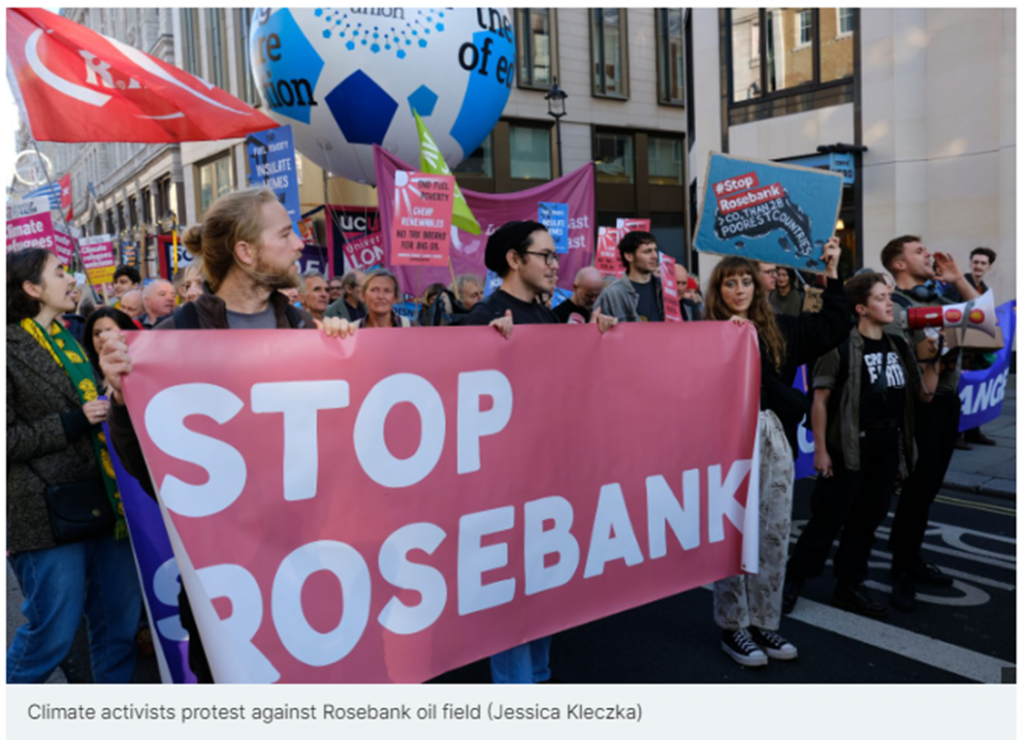
If the views of ordinary residents and Friends of the Earth could be dismissed, surely the Scottish parliament and its First Minister should not have been? :-
“We’ve raised concerns that the majority of what is extracted from Rosebank will go overseas, not remain in Scotland or the UK. We’re investing £500m so workers & industry transition from fossil fuels to a net zero future.
We recognise the significant contribution the oil & gas sector makes to Scotland. However, our future is not in unlimited oil & gas extraction. It is in accelerating our just transition to renewables.”
When Humza Yousaf refers to the just transition to renewables, he knows full well that Shetland is also home to a massive-scale of wind turbine development just completed. And for this the sweeteners for islanders, from installers SSE, were very significant indeed: –
I asked my contact if he could see anything relevant to this week’s decision in Shetland Times, but so far there is no report. So how to wind this up? I will quote Green Party MP, Caroline Lucas, who said:-
“Giving the green light to this huge new oil field is morally obscene. This Government must be held accountable for its complicity in this climate crime.”
“Amidst a summer of raging wildfires and the hottest July on record, this Government approves the biggest undeveloped oil and gas field in the North Sea – set to produce more than the combined CO2 emissions of all 28 low-income countries in the world.”
I find that underlined statement to be mind-blowing and outrageous. What do you think?
A Temperate Rainforest survey
If you were reading last week, you could probably tell my knowledge of how to identify a Temperate Rainforest was scanty! I shared the story last evening with colleagues in an online Valley Partnership meeting and was sent the perfect link, by Jenny Heskett our Valley Ranger. She described a website called Plantlife dot org, where I found that their aim is to be ‘The Global Voice for Wild Plants and Fungi’ and their work is part-funded through the provision of a ‘free’ to customers Will-Writing service. They also strive to balance the books through Membership and Donations (just like Meadow Barns, in fact!).

A major element of the service provided by Plant life is free information booklets, to download. I immediately took advantage of the publication called simply ‘Am I in a Rainforest?’, printed a copy and headed out again to find some answers. https://www.plantlife.org.uk/wp-content/uploads/2023/03/Am-I-in-a-rainforest-Temperate-Rainforest-UK_Plantlife.pdf

Sorry you most likely cannot read all of these questions, but I was certainly able to say yes to the quarry being full of water. I discovered another stream, flowing quite swiftly and not so clogged with silt as the ones we saw last week. There were also swampy places, wet rock faces and general dampness. Tick Tick Tick!
Then to the 2nd page:- yes the ground is lumpy. More than lumpy, look at this stacking of 2 granites like a cottage loaf, amazing! I love the look and feel of all the mosses, and found a particularly beautiful one for us, featuring the star shape, but had not sufficient time to hunt for all the other ones illustrated above. Some Ticks in boxes here. But then, we get to what are the trees?
There are very few ash and hazel, perhaps a handful more oak but this woodland was planted to be a bold statement in beech and occasional rhododendron. Why? Well, through it runs a ‘private carriageway’, made for wealthy landowners to come and supervise works in the mines and quarries during the 1850s to 1880s. Beech was chosen for its architecture, almost creating areas to emulate the nave of a cathedral. Rhododendron had recently become established as a status symbol, having only arrived in the UK in the 1700s.
Some of the original path runs through our family farm of Penpell, and you can see below how the beech were used. In the depth of the quarry itself is a mass of smaller undergrowth, lots of willow, some hazel etc.



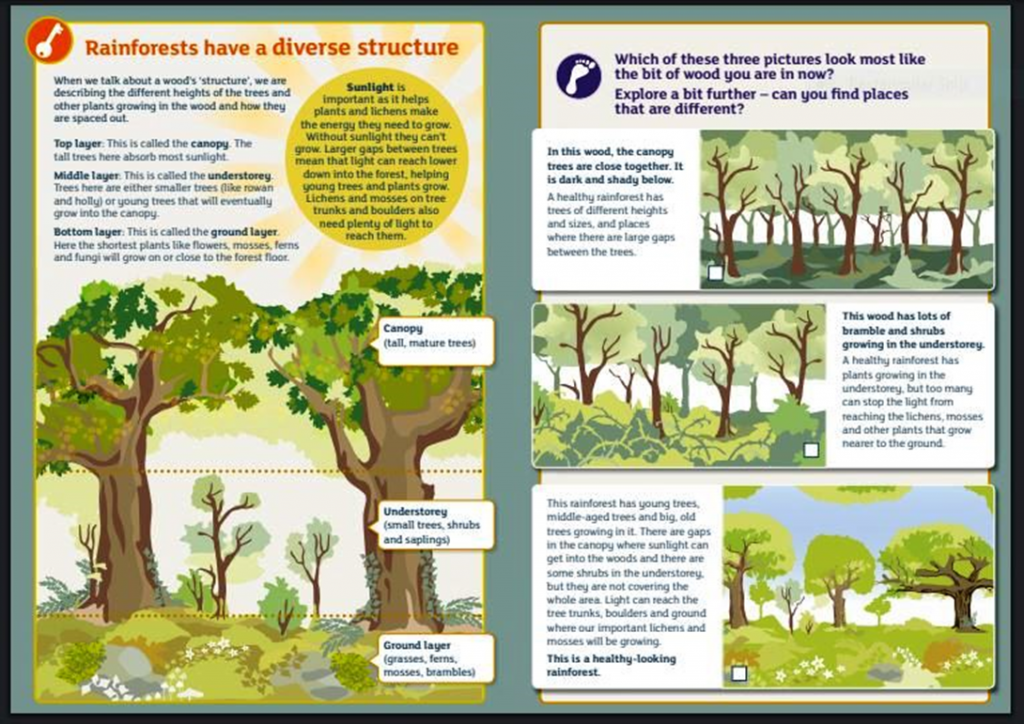
I found this quite a difficult set of questions. There is a fair amount of space between branches, but really the canopy is not open enough to be a healthy-looking rainforest. For the most part it is not growing much in the way of brambles and shrubs either. However, where I could peer into the quarry, it was much more of a jungle.
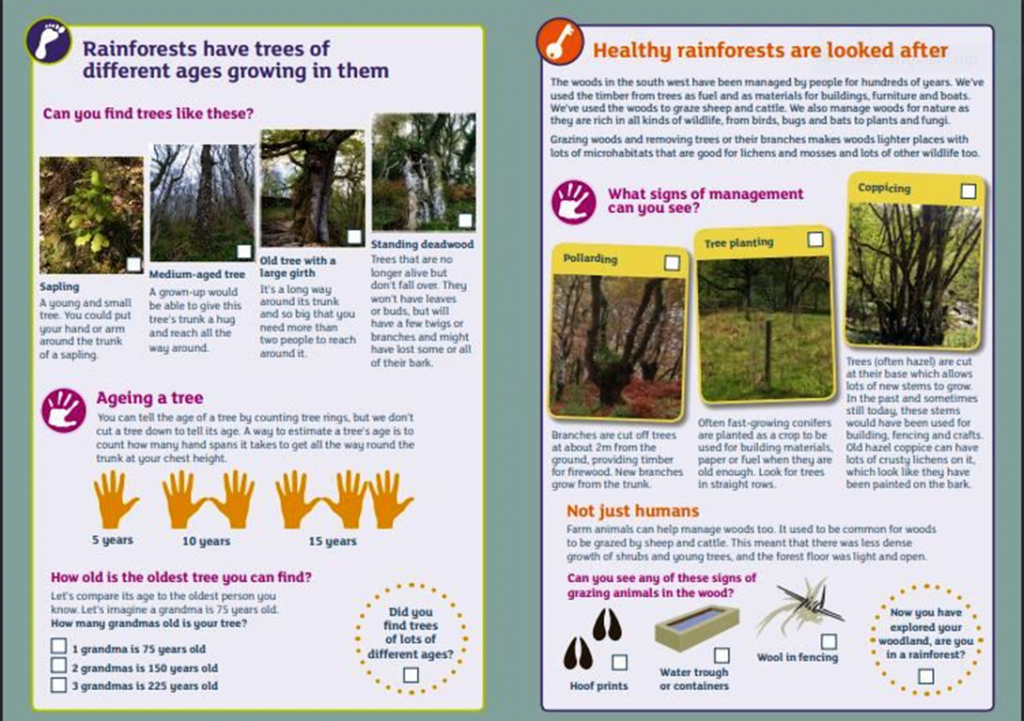


I will be back again and again, with my colleagues, until we have a plan and hopefully support to look after this amazing place, for its nature and heritage.
Finally, to Harvest and Food
The count down to Harvest Half Term has begun and details, including an Eventbrite booking link, are on the website here. https://themeadowbarns.co.uk/climate-festival-2023/
Many organisations and individuals are now coming on board, to help. It seems likely we will get a really wonderful display, of an Apple Tree Avenue with 3 different short dances of pollinators, Apple Pickers and adult Welly Wearers! Then there will be some baking of the apples, honey and seeds, tied with a visit from a beekeeper. Coleslaw and salads feature strongly too, with much thought going into healthy recipes. The Apple cake involves very little sugar or fat and is light as a feather, because there is so much yogurt and eggs in the mix. We will be running a competition to find the finest fruits and vegs in 4 categories: –
- Eating apples
- Salad greens including chards and spinach, plus tomatoes
- Crunchy cabbage for rainbow coleslaw, all colours!
- Chunky root vegs (carrots, swede, potatoes etc) for a recipe that involves roasting with rosemary and cheese
Some will have candles in them, to be used when we make pledges for a better future in farming.
The rest will go towards lunch at the Friday Community Café.
This brings me to a personal decision, taken a month ago. I saw a pre-packed Co-op chicken almost on its expiry date and was persuaded by the very low price of £2.72, to take it home and roast. I was eating it for the rest of the week (people of my vintage were brought up never to waste a scrap!). But increasingly I felt this isn’t a good thing to be doing, first from a dietary viewpoint; it is not a great quality of protein, nor sufficient variety. I began to think I should attempt something different, which I have started and so far I am greatly enjoying – tons of vegs, plus oily tinned fish and grains. My intention is to keep chicken for special occasions and ensure that I only will buy the best free-range local, or organic.


Nutrition isn’t the end of the story. What about chicken from an environmental perspective? It was not until I had a reminder of the terrible effect that chicken manure has on some of our major rivers that I turned my attention to this side of the story. ‘Rivercide’ was a documentary made 2 years or more ago, but by now had fallen off my radar. This more recent series, ‘Our Troubled Rivers’ with Paul Whitehouse, is on primetime BBC so is more likely to make an impact. But the message is identical, the River Wye is being totally poisoned by excess amounts of thick algae, like pea soup, that grows in response to mega tons of chicken manure from almost 20 million intensively reared birds in the Wye catchment. Find the start of the report here, 9 minutes in and if possible I recommend also seeing the farm visit at 14 minutes, where you get the whole story of how much pressure the farms are under and how little discretion they have as part of the UK intensive poultry production-line (I won’t pretend it is a fun watch, but not nearly as bad as the horrible example, set in America, if you look for ‘True cost of Cheap Chicken’ online):-


A farmer’s wife describes the regulations in place, which are meant to control the situation by insisting that farmers observe a manure-free buffer strip alongside every waterway. But the boundary is only 3m, which Paul observes seems very close. By permitting such an inadequate buffer strip the Environment Agency is basically killing the entire river and wildlife in it.
Another source you might look for is an article I came across in the Daily Telegraph called ‘The True Cost of Cheap Chicken’. This says how the common view of chicken being better for the environment than beef, lamb and pork is misleading: –
Yes, ‘intensive chicken is a more efficient converter of plants into food than most other animals, better than pigs, for example, in terms of carbon footprint,” explains Mike Berners-Lee, an English researcher and writer on carbon footprinting. “And better than sheep and cows because they don’t ruminate, so there’s much less methane involved.” However, this does not take into account the carbon footprint of imported food stuffs:-
UK emissions figures currently exclude net imports, so they miss the carbon footprint from imported feed from the Americas. 41.5 per cent of the world’s crop-based feed is used in poultry production and 60 per cent of the soy imported into the UK is for the poultry industry,‘ say the Soil Association.
Nor does it factor in the ever-increasing threat from Avian flu plus routine, round the clock antibiotic and growth hormone treatments
“Specifically, it is our chickens that are pushing the bird flu.” If it were to come across to humans, it would have a devastating effect,” Berners-Lee suggests.
He adds “global concerns about antibiotic resistance are also fuelled by intensive poultry farming. Two thirds of the world’s antibiotics are fed to farm animals, not humans.”
There are some good news stories in both the BBC film and the Telegraph piece. The film shares a story of using beaver dams to help filter out phosphates, whilst the newspaper describes 2 farms where regenerative practices see outdoor birds running in tandem with Herefordshire cattle. Farmer Jon says “We’re pasture for life. Our grasslands are where we are going to be sequestering the most carbon in the UK and it’s about managing those to also produce nutrient-dense beef alongside the chicken rearing and 200 eggs laid each day”.
And the price differential? Close to £3 per kilo for intensive factory-bred chicken compared with anything from £7.50 to £10 per kilo for the quality, organic meat. The Telegraph concludes, as I have, “Really, we need to go back to chicken being something we eat quite rarely rather than on a daily basis,”

